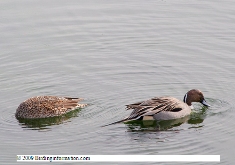Nutrition
As part of being classified under the
order Anseriformes, Pintails and all the
birds of this order are generally considered
herbivores. The pintail however is well
known as an omnivore, meaning it feeds on both animals and plants. In
 general the
Pintail consumes many different types of
water plants and the seeds these plants
produce. Like some other ducks, it dips its
head below the surface with its tail in the
air to feed (dabbling), maintaining balance by paddling
its feet. However because of the Pintail's
exceptionally long neck it can feed on the
bottom of ponds and marshes, even lower than
other duck species. Variations in diet do
occur due to several things. The females
especially go through different diets based
on where they are in the
reproduction cycle. The consumption of
invertebrates is greatest when the female is
in the process of laying her eggs. This
could be due to the fact that while laying
she does not want to travel to the water for
food. This increase in invertebrate
consumption drops just as quickly as it
starts once the laying period is over. The
intake of animals also drops when the ducks
are molting. All in all, Pintails are very
good at taking advantage of what is most
available to them. If there is a lack of
vegetation,
general the
Pintail consumes many different types of
water plants and the seeds these plants
produce. Like some other ducks, it dips its
head below the surface with its tail in the
air to feed (dabbling), maintaining balance by paddling
its feet. However because of the Pintail's
exceptionally long neck it can feed on the
bottom of ponds and marshes, even lower than
other duck species. Variations in diet do
occur due to several things. The females
especially go through different diets based
on where they are in the
reproduction cycle. The consumption of
invertebrates is greatest when the female is
in the process of laying her eggs. This
could be due to the fact that while laying
she does not want to travel to the water for
food. This increase in invertebrate
consumption drops just as quickly as it
starts once the laying period is over. The
intake of animals also drops when the ducks
are molting. All in all, Pintails are very
good at taking advantage of what is most
available to them. If there is a lack of
vegetation, their diet will consist almost
entirely of animals. During the spring, when
midge pupae come to the surface of ponds,
they do a lot of surface feeding. It all
depends on what is around them given their
diverse
habitats.
their diet will consist almost
entirely of animals. During the spring, when
midge pupae come to the surface of ponds,
they do a lot of surface feeding. It all
depends on what is around them given their
diverse
habitats.
Pintails have an incredibly diverse diet
but to get a glimpse of some of the
organisms they eat, check out these
websites:
Damselfly
Faucet Snail
Daphnia